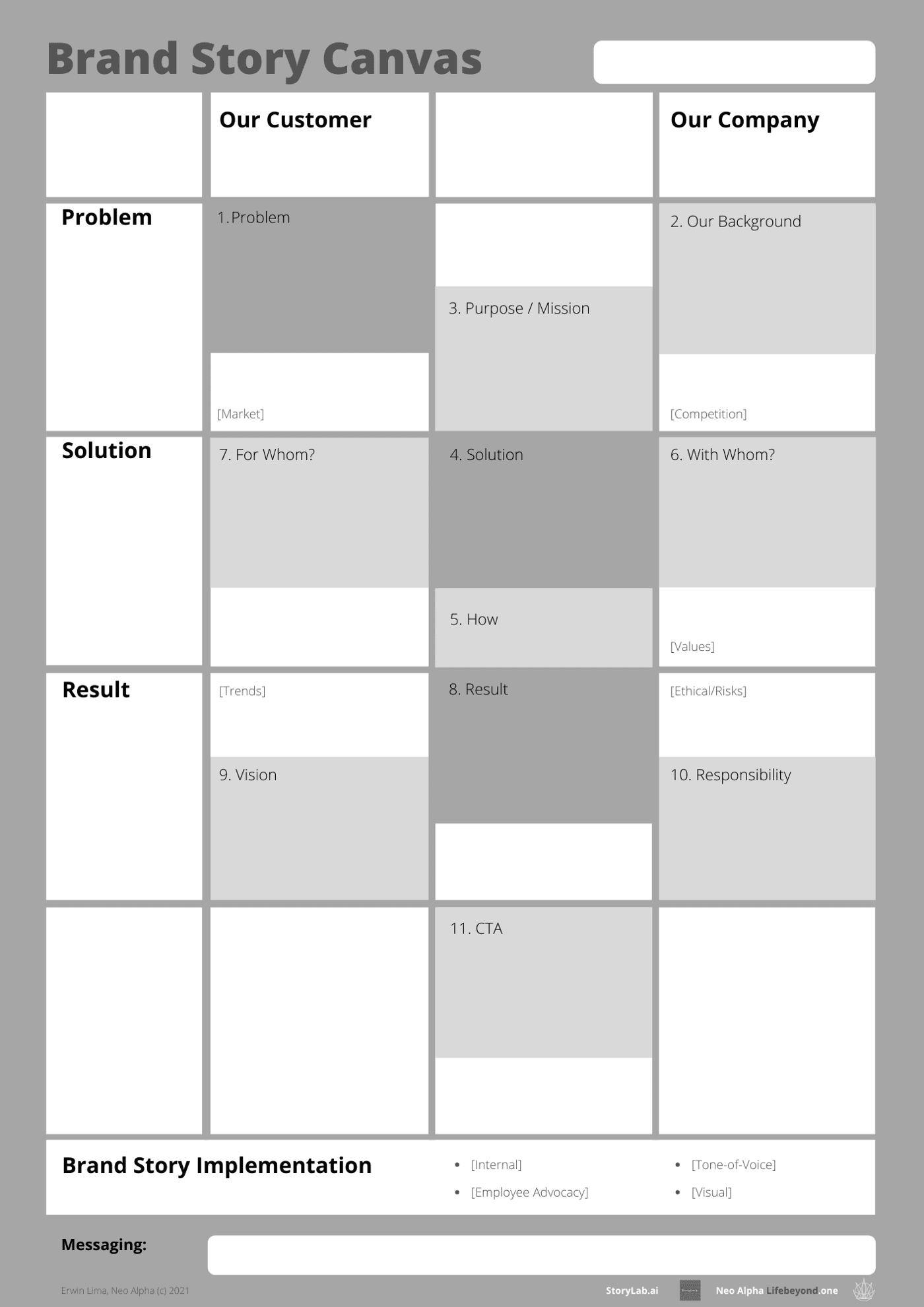How to Create your Brand Story [Guide & Template]
Introducing the Brand Story Canvas
Sometimes you don’t even realize that a certain project at work is going to prove to be so important to your development as a professional and as a human being.
About 7 years ago I was working as a content marketer for a tech company. Under the guidance of two very strong and experienced marketing professionals — one with a deep expert-level knowledge of Brand Identity — I wrote the company’s Brand Book. Too. Much. Fun. And learning.
That exercise and what I learned about Brand Storytelling in it, helped me build a foundation for the creation of Brand Stories that I have used many times since.
Brand Stories I create not only help organizations grow, they give them more direction, inspire customers and sometimes even — rather magically — get founders and team members to tears.
I use the same basic psychology and framework to help growth-minded individual human beings to find their purpose and write what I call their “Growth Stories”. Here’s what people have said about that.
Brand Story: at the core of your approach to content

Your Brand Story together with the visual and other aspects of your Brand Identity, should be at the core of how you approach your content and other marketing strategies and tactics.
In this article, you’ll learn how to create your own Brand Story, with a Brand Story template to make the work even more fun, easier, and more effective.
Who this is for
This is for anybody who’s responsible for the growth and storytelling of a company. Or for content creators who want to get a bit more strategic and professional with how they present themselves and use storytelling to reach their goals.
For any founder of a startup, for any lone entrepreneur, for anybody working in marketing — be it as a CMO, content marketer, or head of brand.
This is for you if you’re thinking about creating a new or renewed brand identity for your company. Or if you want to take your content marketing to the next strategic level.
At StoryLab.ai and at Neo Alpha we believe telling your stories the right way, helps you and other people grow. Getting your Brand Story down properly, is an important first strategic step. Here’s how to do it.
What you will learn in this article and resources
What is a Brand Story?
At its essence, a Brand Story is the story of how you as an entrepreneur, content creator, or company came to be who you are right now; what drives you, what you can do for people, and how you aim to grow in the near future.
At the simplest, most essential level, it consists of three elements related to your past (I), present (II), and future (III).
Through those same three elements, your story speaks about the need (I) you identified and that drove you to do what you do; the solution (II) you landed on, and the result (III) that it gave you or that it gives other people (your customers) to use that solution.
The goal of brainstorming and writing down your Brand Story
The goal of brainstorming and writing down your brand story is threefold:
- It helps you understand yourself
It helps you understand yourself better because really brainstorming about who you are as an entrepreneur, content creator or as a company, makes you think deeply about fairly difficult questions. If your brand is connected to a company of two or more people, it will also help get everyone on the same page, to huddle around that page and write down your story. - Helps you focus
It helps you and/or the people that you work with stay on track: it gives you focus to write down your story, even if only your Purpose or Mission statement, and your vision. - Helps you tell the stories that help you grow
It helps you to tell other people — these could be potential partners or potential customers — about who you are and what you stand for. This helps you grow much more easily in terms of sales and revenue if you’re a company, and in terms of reach and following if you’re a content creator. It can also, obviously, help you with both.
Why it’s important to create your Brand Story, from an (HR and) marketing perspective
Human beings need each other to grow. You need to be able to tell people what you’re about to get anywhere. It’s hard to make it more simple than that.
People want to connect to and buy from other people, preferably from people that believe in what they believe in.
Here’s why a Brand Story is so important from a brand-building or marketing point of view:
- Brand identity is important because it gives you direction, and;
- Brand Story is the foundation of your Brand Identity.
- If applied consistently a well-founded Brand Identity will help you get people to trust you and to be able to reach your goals.
A strong Brand Identity and having a clear sense of purpose gets you and/or your people to be happier and more engaged, which in turn helps you create more value for your audience and/or customers. And gets you more revenue in the long run, especially if you implement it correctly in your Inbound Marketing Strategy if that’s the sort of thing that you’re into.
Your Brand Story is at the core of that Brand Identity.
How to create your Brand Story in four steps
The first and foremost thing you need to do to create your brand story, is to seriously reflect. What is at the core of your company or the content you want to create? Why are you here and why do you do what you do?
Step 0— Self-reflection
Think seriously about who you are, alone or with others. Regardless if you’re a lone content creator or solo entrepreneur, or if you’re attacking this from the standpoint of a larger organization, I’m sure you could use some help. If so:
Brand Story Template: Introducing the Brand Story Canvas
Now, here’s the Brand Story Canvas: a model that can help you brainstorm — alone or with others — what the elements of your Brand Story should be. I use it with my clients, in the exact same three steps that I’ll lead you through in a second.

Step 1— Start with mapping at the most basic level
Start by filling out the boxes for Problem (1), Solution (4), and Result (8). You can literally do this with sticky notes, digitally in a board in MIRO or some other visual collaboration tool. The idea here is to have everyone on the team answer the following questions:
- Problem
What problem(s) have we identified in the market, that our product/services/existence is an answer to [no more than 5 lines of text]? - Solution
This is your overall value proposition. How would you describe and/or summarize your solution/products/services [no more than 5 lines of text]? - Result
What is the result that using your solution gets the people that use it [no more than 5 lines of text]?
To create the first draft version of your Brand Story from this brainstorm, first let everyone on the team provide feedback on what the others said, and “star” or underscore words and phrasings that they liked. Then summarize the story out of elements 1, 4, and 8 in a maximum of 3 x 5 lines of text.
Step 2— Add Mission/Purpose (3), How (5), and vision (9)
Fill out boxes 3, 5, and 9 in the same way as you did in step 1, answering the following questions:
- Mission/Purpose
What drives you as a creator, as a founder, or as a company? Why do you exist and what do you want to change in the world [max 5 lines of text]?
Your Mission statement should land exactly in the sweet spot between what you already are, and what you’re trying to grow into. It should be an inspiring challenge to who you are, now. - How
How do you work, and how is the way you do what you do different? How does your approach to what you do (your solution; .4) add value [max 5 lines]? - Vision
What is the future of the space that you’re active in, and what is your role in that future [max 5 lines]?
If you’re a startup, the six elements of your Brand Story that you have now, are the first thing you need. If you have these, you can start filling content and descriptions for your website, social media, company presentation, et cetera.
For my clients, in this phase, I like to deepen the work by introducing an in-depth conversation or interview about the core of the company and what drives them.
Obviously, you need to take progressive insights into account and use them to improve the Brand Story elements you already created, as you go along.
Step 3— Round out the missing parts and complete your Brand Story
Add Core Values, With whom (your team and/or business partners), For whom (describe your audience or customer persona), Responsibility (how do you take social and/or environmental responsibility), and your CTA or CTAs (calls-to-action; what can people do to get involved/buy what you’re offering?).
If you can, devote a bit of extra time and attention to think about the background of your company/you as an entrepreneur or creator: What about your history is relevant to the problems (1) that you’re solving, the solution (4) that you provide and your mission (3)?
Use the white boxes in the template to gather notes about the market, your competition, relevant trends, ethical concerns, and risks to guide you in the writing and editing of your final version, your Brand Story V1.0.
Finally, summarize what you or your company are and what you offer in a short descriptive tagline. For StoryLab.ai for instance, this is it:
“Write more and better stories, faster. StoryLab.ai”
Step 4 — Brand Story implementation
If you’ve followed all the steps above, and have edited your story to sound smooth, and, essentially, to communicate the correct feeling — as checked by collecting feedback on your first version from people around you to whom this story should matter — congratulations: You’ve got your Brand Story V 1.0! Now, how do you start using it, and how do you use it to the fullest effect?
For this crucial last step, the implementation of your Brand Story, it’s important to think about the following questions:
- What parts of the story go where?
(Abbreviated versions of ) parts 1, 4, and 8 obviously go on your homepage — a summary of these and your mission, in combination with your summarized messaging in the bottom box of the Brand Story Canvas go on your social media profiles and bio’s. Other parts of this Brand Story go in the “About us” page on your website and deeper company profiles in other places.
The whole of the Brand Story can go in internal documents for HR and recruitment purposes, and in presentations for sales. Among other things.
A really great aspect of this is that you’ve created 6–12 blocks of copy that you or anyone you work with can use over and over again to talk about your brand.
Finally, each separate block of text from the story can be expanded into a blog article or used simply as a social media post or else, in order to tell the story of your Brand and to start loading your Brand Identity and values.
- How to reinforce internally?
Introducing a new Brand Story and Brand Identity is not a matter of present and done. It’s imperative — especially in larger organizations — that you think about and create a plan for how to integrate the story in the way you approach leadership, HR, sales, recruitment, and of course marketing processes.
- What about employee advocacy?
Think about how each individual employee can connect to the story and values in your Brand Story, to improve both its internal and external value.
- What about Tone-of-Voice?
The box with “Values” Connected to part .5 “How”, together with your mission, your team (.6 “With Whom?”) and your target audience (.7 “For Whom?”) should tell you how formal or informal, how serious or humorous, how warm or cool, et cetera, your Brand Tone-of-Voice should be.
Along with your Brand Story, write down your Tone-of-Voice and store it in a place where everyone you work with can always access it easily.
- What about visuals?
The same boxes that inform your Tone-of-Voice should also inform your visual style (logo, colors, design ratios et cetera). In addition, the competitive landscape can give you clues on what colors or shapes to use or to avoid to be sure to stand out amongst the competition.
You can use the StoryLab.ai Style Guide Template to pin down and distribute your Brand Style Guidelines to relevant stakeholders.
Use our AI Copy generator to generate or iterate your Brand Story
StoryLab.ai is an AI copywriting tool that helps you create better content, faster. You can use our Social Caption Generator, Blog Intro or Tone Changer to either create copy for your brand story from input in the form of keywords and phrases.
Or, better yet, you can write the first version of your Brand Story text blocks yourself, and then input these blocks in one of the above generators — our tool will come up with different variations. Rest assured, you can try out any of our AI content generator tools for free.
Need more help creating your Brand Story with AI? Here’s a step-by-step guide to creating your Brand Story with the help of our AI Copy generator:
Creating your Brand Story with the StoryLab.ai Copy Generator
Step 1: Answer the Brand Story questions in keywords
Take a look at the Brand Storytelling Framework. Next, answer the 11 questions you need to start building your Brand Story in keywords and phrases:
- Problem. What is the problem you’re solving?
- Origin. What is the background of the company/brand/founders as is relevant to your products and services?
- Purpose. What is the Purpose/Mission of the brand/company?
- Solution. What is the solution or how do you summarize the services/products that you offer?
- How. How does the way you offer your solution or how it works make the difference for your target audience?
- With whom. Who do you work with; who are on your team/who are your business/network partners?
- For whom. Who do you work for; how would you describe your target audience or target customer?
- Result. How would you describe the result that your product/services get your customers or audience?
- Vision. What is your vision for the space/niche that you operate in and what is your place in that future?
- Responsibility. How does your organization/brand take responsibility (ethics, CSR) within the space you operate in, in the work that you do and how you do it?
- CTA. What can people do if they’re interested/want to find out more/want to connect/want to buy your services/products?
Step 2: Input your keywords in our AI Copy Generator
After you’ve written down your answers to the above questions in keywords or phrases, take those answers and insert them as input for our Social Caption Generator.
Find our Social Caption Generator here.
You’re looking for a first version of each part of your Brand Story, that you can later improve upon. Once the generator has given you an output that you like well enough as a start, move on to the last step:
Step 3: Improve your AI generated Brand Story with a human touch
Take your AI-generated first draft of your Brand Story, and improve it. Tweak the phrases, words, the rhythm and the overall tone-of-voice to the point where this story represents you and your company or brand perfectly.
*The best part here is that you don’t have to come up with any copy by yourself; the AI is giving you a first draft; something to start off with and improve.
**As always, be sure to get the most out of AI copy generators by making sure you as a human, do the final editing.
Use our Growth Storytelling Framework to get the most out of your Brand Story
Our Growth Storytelling Framework combines Content Strategy, our Storytelling Framework, an SEO checklist and Content Distribution Framework among other things. It gives you all you need to be assured you’re getting the most out of any and all content you create and distribute — your Brand Story is an integral part of that. Access the Growth Storytelling Framework here, for free.
As always: happy growth, and happy writing!

FAQ
What is a brand story?
A brand story is a cohesive narrative that encompasses the facts and feelings created by your brand. It’s not just the content and facts about your brand, but also the emotions your brand evokes in its audience.
Why is a brand story important?
A brand story helps to create a connection with your audience, conveying not just what you sell, but who you are, your values, and what you stand for. It’s essential for building brand loyalty and emotional engagement.
How do you start creating a brand story?
Begin by understanding your brand’s mission, vision, and values. Identify the key messages you want to convey and the emotions you want to evoke. Then, craft a narrative that aligns with these elements.
What are the key components of a successful brand story?
A successful brand story includes a relatable protagonist (your brand or customer), a challenge or problem, a solution your brand offers, and the successful outcome or transformation.
How can a brand story be integrated into marketing?
Integrate your brand story into all aspects of your marketing – from your website, social media, and content marketing, to your packaging and customer service.
What role do customers play in a brand story?
Customers can be the heroes of your brand story. Showcasing their journeys, challenges, and how your brand has helped them can make your story relatable and powerful.
How does a brand story differ from a marketing campaign?
A marketing campaign is a specific, targeted effort to promote a product or service, while a brand story is the overarching narrative that informs all marketing and communication strategies.
Can a brand story evolve over time?
Yes, a brand story should evolve as the company grows and the market changes. It should remain authentic but adapt to stay relevant and resonate with your audience.
How do you measure the effectiveness of a brand story?
Measure effectiveness through engagement metrics, brand awareness surveys, customer feedback, and by assessing the impact on sales and customer loyalty.
What are common mistakes in creating a brand story?
Common mistakes include lacking authenticity, being too sales-focused, not aligning with the audience’s values or interests, and failing to communicate a clear and consistent message.
How can storytelling techniques improve a brand story?
Storytelling techniques like a strong narrative arc, emotional appeal, and relatable characters can make a brand story more engaging and memorable for the audience.
What is the role of company history in a brand story?
Company history can add depth and authenticity to a brand story, illustrating its journey, evolution, and the milestones that define its identity and values.
How should a brand story be communicated to the audience?
A brand story should be communicated consistently across all channels – website, social media, advertising, PR, and customer service – to ensure a unified brand experience.
Can customer testimonials be part of a brand story?
Absolutely, customer testimonials can be a powerful element, providing real-life examples of how the brand impacts its customers, adding credibility and relatability.
How important is visual imagery in a brand story?
Visual imagery is crucial as it helps to convey the emotions and themes of the brand story, making it more engaging and helping it to resonate with the audience on a visual level.
What’s the difference between a brand story and brand messaging?
A brand story is the overarching narrative that gives context to your brand, while brand messaging is how you communicate specific aspects of this story through marketing and advertising.
How can a brand story be aligned with customer values?
Understanding and reflecting your audience’s values in your brand story strengthens the connection with them, making your brand more relevant and appealing.
Can social media be used to tell a brand story?
Social media is an ideal platform for storytelling, allowing for regular, engaging content that can illustrate different facets of your brand story to a broad audience.
How does a brand story contribute to brand identity?
A brand story is a foundational element of brand identity, encompassing and conveying the essence, values, and personality of the brand in a narrative form.
What are the challenges in creating a brand story for a small business?
Challenges for small businesses might include limited resources, finding a unique angle in a competitive market, and effectively communicating their story on a smaller scale while maintaining authenticity and impact.
Author bio:
 Erwin Lima: What inspires Erwin is helping people, teams and brands to become the best version of themselves. Guiding them with curiosity, empathy, and Growth Storytelling.
Erwin Lima: What inspires Erwin is helping people, teams and brands to become the best version of themselves. Guiding them with curiosity, empathy, and Growth Storytelling.
Over the past 10+ years as a copywriter, author, consultant, and coach, he’s helped dozens of Brands, Teams, and individual human beings to grow their sense of motivation and focus, but also their reach, engagement, and revenue— through the power of their own story. You can find Erwin on LinkedIn and on his website.
